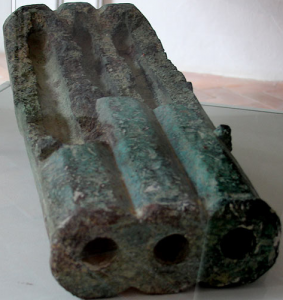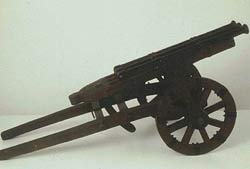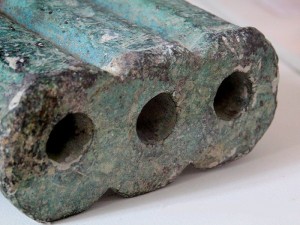In 1968, a group of schoolchildren exploring the fortress of Klicevica in what is now Croatia stumbled on a bronze triple barrel cannon. After the dissolution of Yugoslavia and the Croatian War of Independence (1991-1995), the cannon was donated to Croatia’s Benkovac Heritage Museum. It’s a rarity as very few triple barrel cannons have ever been found (here’s an early 18th century example), but the full history of the piece is unknown.
 It was definitely used at least once since the underside was blown off in a botched firing. A large number of bullets and artillery from the 15th and 16th centuries have been found in and around Klicevica Fortess. The fortress was one of a series built to defend the border of what was then Dalmatia after the king of Naples sold the territory to the Republic of Venice in 1409. It was heavily armed and fortified to repel the invading Ottoman Turks who finally conquered the area in 1527.
It was definitely used at least once since the underside was blown off in a botched firing. A large number of bullets and artillery from the 15th and 16th centuries have been found in and around Klicevica Fortess. The fortress was one of a series built to defend the border of what was then Dalmatia after the king of Naples sold the territory to the Republic of Venice in 1409. It was heavily armed and fortified to repel the invading Ottoman Turks who finally conquered the area in 1527.
Curators at the Benkovac Heritage Museum have been researching the triple barrel cannon assiduously. They excavated the discovery point in an attempt to confirm its age and were able to date it to the late 15th century. Because the fortress was under Venetian control at that time, the museum consulted with armaments experts in Italy to see if they could narrow down its designer. They found that the triple barrel almost exactly matches a sketch made by Leonardo da Vinci that is currently in the Codex Atlanticus in Milan.
“We think it was either made in Venice and brought here, or it may have been made locally,” said Marin Curkovic, the director of a museum in the nearby town of Benkovac, where the cannon went on display this week as the centre-piece of a new exhibition.
“We cannot say with 100 per cent certainty that it was built to Leonardo da Vinci’s designs but the resemblance to his sketches is remarkable. We think there is a very high probability that it was manufactured to his designs.”
 There’s a replica made from the drawing in the Leonardo da Vinci Museum of Science and Technology in Milan, but other than that, there is no other version anywhere in the world, certainly no original ones dating to the 15th century. There isn’t even any documentary evidence that any of the many war machines Leonardo invented were ever fabricated. This could be the only one.
There’s a replica made from the drawing in the Leonardo da Vinci Museum of Science and Technology in Milan, but other than that, there is no other version anywhere in the world, certainly no original ones dating to the 15th century. There isn’t even any documentary evidence that any of the many war machines Leonardo invented were ever fabricated. This could be the only one.
 The standard cannon of the period was hard to move and slow to load. Because of this, they were used mainly in stationary positions, like on castle ramparts, rather than on the battlefield. The triple barrel cannon was Leonardo’s solution to these problems. According to the sketch, the triple barrel cannon would have been mounted on a wooden carriage with large wheels so it could easily be moved. The barrels were smaller and lighter weight and could be loaded and fired more rapidly. There was also an elevation adjusting mechanism that used a peg blocking system for the barrels to be aimed with greater accuracy.
The standard cannon of the period was hard to move and slow to load. Because of this, they were used mainly in stationary positions, like on castle ramparts, rather than on the battlefield. The triple barrel cannon was Leonardo’s solution to these problems. According to the sketch, the triple barrel cannon would have been mounted on a wooden carriage with large wheels so it could easily be moved. The barrels were smaller and lighter weight and could be loaded and fired more rapidly. There was also an elevation adjusting mechanism that used a peg blocking system for the barrels to be aimed with greater accuracy.
Although this particular design is not available online, you can leaf through some of his other inventions on the pages of the Codex Atlanticus scanned by the Ambrosiana Library in Milan.
Ouch! Obviously, the gunner on this contraption had a nasty surprise. How large is it? The piece looks rather small judging from the first picture where it appears to be sitting on the corner of a tabletop. If so, it might be something less than a true canon and more like a three-barrel culverin. See more here at: http://en.wikipedia.org/wiki/Culverin
Nice post! I posted this myself a day before the news broke out only to find out that there is another one buried somewhere in the town!
http://secretdalmatia.wordpress.com/2011/06/08/triple-barrel-canon-by-leonardo-da-vinci-in-benkovac/
Fascinating!
I visited the fortress Spanjola in Hvar, Croatia last year. There’s a 19th century French made cannon on display.
By the way, I’m a new reader!
It’s actually not on a table but on a floor display. Still, it’s definitely smaller than some of those culverins in the link. The vertical ones are huge!
Ooh, intriguing! Time for the anonymous gentleman to tear up his backyard. 😀
Croatia has seen more than its fair share of military history, that much is clear.
Welcome! Thank you kindly for reading and for commenting. 🙂
This is old school automatic artillery. I don’t think it worked very well because we would probably see more of this types of weapons. Anyway it was good idea for the time.
:hattip: :hattip: :hattip: :hattip: :hattip: :hattip: :hattip: :hattip: :hattip: :hattip: :hattip: :hattip: :hattip:
Multi barrel cannon have always been popular with designers but consider the gunner. Three shots and then reload. Two barrels loaded and the enemy getting closer. He is now standing in front of two loaded barrels, the enemy behind and the man with the match is getting nervous!!!
Cannon have a tapered barrel for the good reason that the pressure is highest at the breech. To make the bores parallel the walls are thinner, and therefore weaker, at the breech and this is exactly where the ‘Leonardo’ gun failed.
Leonardo was a great artist and an imaginative designer but his practical engineering skills were less impressive.